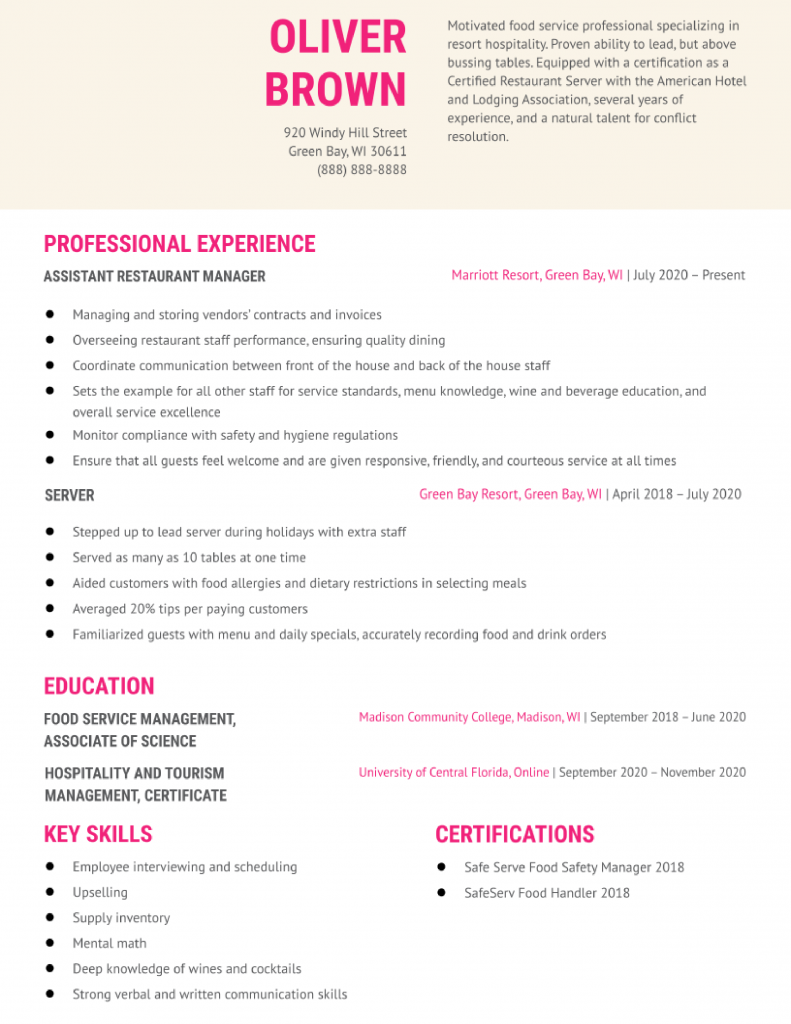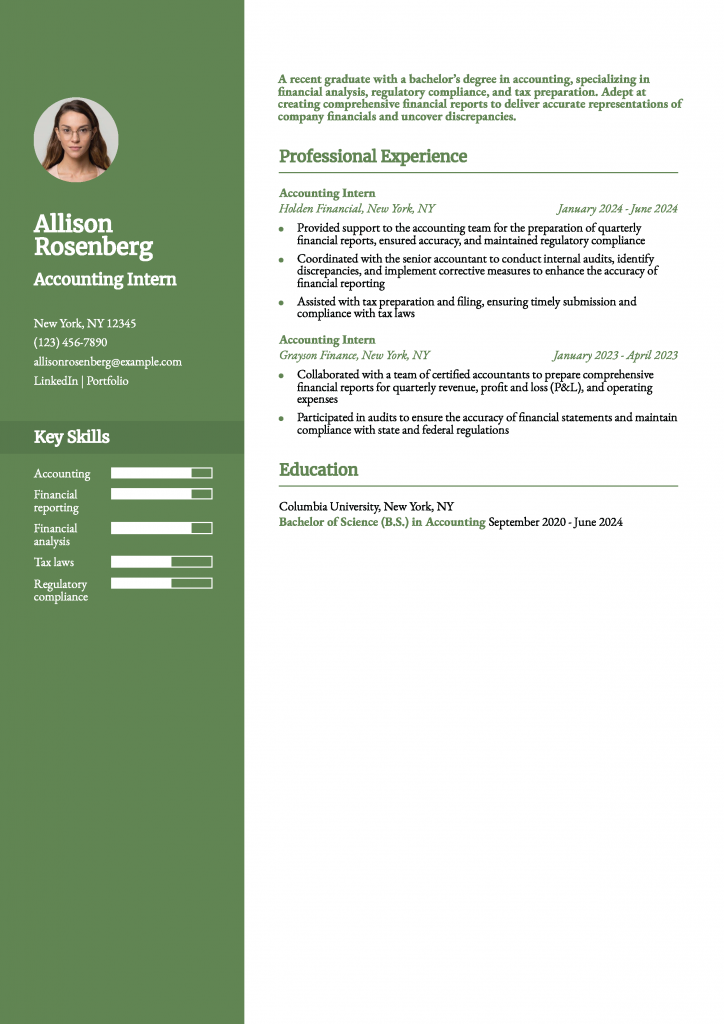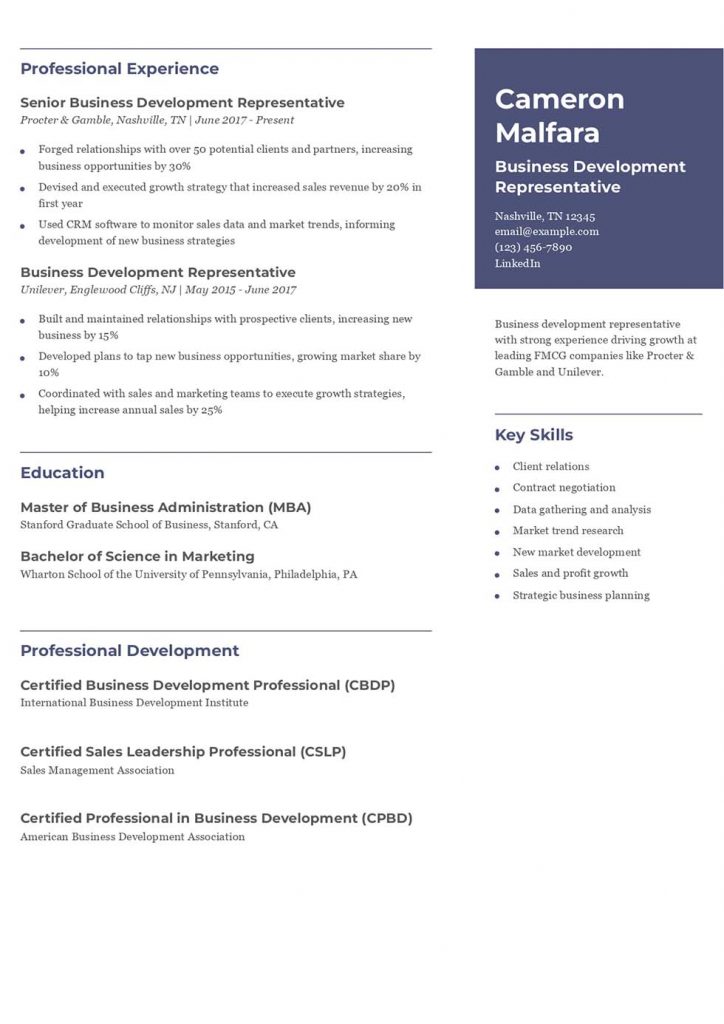Resume building isn’t a one-size-fits-all process. The proper way to list your education and academic achievements varies depending on your career and target industry. For example, the education section for a graduate school student will be vastly different from that of a project manager with 10 years of experience.
Understanding how to tailor the education section on your resume to your career goals is crucial. Whether you’re a recent graduate, mid-level professional, or someone re-entering the workforce, these resume examples can provide insight into the right format for you.
Throughout this guide, you’ll see a number of ways to build the education portion of a resume and feature the most compelling aspects of your academic background.
Five Simple Steps To Craft Your Education Section
Regardless of your career level, the way you present your academic achievements can impact your job application and the way hiring managers perceive you. If you’re wondering how to put education on your resume, the following steps will help you present your scholarly accomplishments in a way that adds value to your resume template:
1. Determine what to include in your education section
2. Choose the right place for your education section
3. List unfinished degrees appropriately
4. Consider whether to include a General Educational Development or high school diploma
5. Include relevant coursework and academic projects
Step 1: Determine what to include in your education section
Always include your most recent degree first, followed by the university’s name. If you’ve obtained multiple degrees, feature them in reverse-chronological order. Include your major, graduation dates, and the location of the university.
If you have decades of industry experience, including your graduation dates may run the risk of age bias among hiring managers. This won’t always be the case, but because you won’t fully understand a company’s work culture until you’ve worked on their team, be sure to weigh the pros and cons of including graduation dates.
For example, if you’re highlighting accomplishments from jobs earlier in your career that are truly impressive, omitting a graduation date won’t do much to hide your age. Sometimes the right approach is to simply let your achievements speak for themselves rather than obscuring your timeline. If you’re unsure about what to include beyond your education section, consider reviewing what to put on a resume to help balance your academic and work experience effectively.
Recent Graduate Example:
In the example below, the candidate is pursuing a graduate degree in psychology. In addition to showcasing their high GPA and awards, they also demonstrate their involvement in the school community by mentioning their membership in various clubs. This information helps admissions officers gauge student suitability for their graduate programs just like an employer would for a job.
Education
Bachelor of Science (B.S.), Psychology
Temple University, Philadelphia, PA, May 2022
GPA: 3.8
- Vice President, Temple Student Psychology Association, 2020 – 2022
- Member, Psi Chi Psychology Honor Society, 2018 – 2022
- Dean’s list 2018 – 2022
- Magna cum laude
Mid-Career Professional Example:
If you find yourself in the middle of your career, you may have more than one degree you’d like to display. In the following example you’ll notice that while the degrees are listed appropriately in reverse chronological order, they don’t include academic awards or their GPA. From this point on in a career, that information is less important to include in the education portion of a resume. If you’re transitioning to a new field or updating your resume, browsing targeted resume examples can help you understand what details to prioritize in your education section.
Education
Master of Fine Arts (M.F.A.), Graphic Design
School of Visual Arts, New York, NY, May 2015
Bachelor of Fine Arts (B.F.A.), Visual Arts
California Institute of the Arts, Valencia, CA, May 2009
Senior-Level Professional Example:
In the next example, our candidate has completed multiple degrees in the medical field and likely has a long-standing career. At this stage, education on a resume validates your qualifications and depth of knowledge. Unless it’s imperative to the job, only list degrees going back 10 to 15 years. This will help you avoid any potential for ageism and keep this section concise. Senior professionals can benefit from reviewing resume examples to streamline their education section while maintaining focus on accomplishments
Education
Doctor of Philosophy (Ph.D.), Medical Science
University of Michigan, Ann Arbor, MI, June 2018
Master of Education (M.Ed.), Instructional Design
University of Michigan, Ann Arbor, MI, September 2011
Bachelor of Science (B.S.), Medical Science
University of Michigan, Ann Arbor, MI, May 2009
Step 2: Choose the right place for your education section
Where to place your education on your resume will also be determined based on your level of experience and career goals. A recent graduate with no relevant experience can place this at the top of their document, while a seasoned professional will put this section towards the bottom.
If you’re an entry-level professional who recently completed an impressive internship, you may want to consider featuring that experience above your degree. As a general rule, hands-on industry experience should always take priority over the education section.
For more guidance on formatting and structuring your resume, check out these best resume formats that can elevate your education section and highlight your strengths.
The following examples will give you an idea of how you can orient your education section on your resume. Whether you’re a new graduate or a professional, reviewing targeted resume examples can help you determine the ideal placement of your education section to complement your work experience.



Step 3: List unfinished degrees appropriately
Can you include a degree you haven’t finished yet? According to executive resume writer Donna Sveid of AvidCareerist, yes, you can list this experience on your resume. Having some college is certainly better than none in the eyes of hiring managers and they often find value in the coursework you have completed. This is especially true if the classes were related to the job you’re applying for.
When including an unfinished degree, be honest and clear. Although it’s common for many applicants, lying or stretching the truth isn’t always a good idea when it comes to your education.
Here are a few tips to help you present partial education on a resume:
- Be honest with dates: Those not actively working toward a degree can provide dates of attendance. If you’re including coursework, this guide on how to list relevant coursework on a resume can help you present unfinished degrees and specific skills effectively. And if you’re currently enrolled and attending classes, list your expected graduation date. This provides context for potential employees and helps avoid assumptions about gaps in your education.
- Provide helpful details: Any unfinished degrees should be accompanied by the number of credits completed unless you’re still working toward your degree. Additionally, consider listing relevant coursework in connection with your degree if you think it could apply to the job or prove you’ve developed technical skills for the position.
- Place toward the bottom: In most cases, experience will always be a priority over your education. So, if you plan on including an unfinished degree on your resume, it’s best to keep it toward the bottom of your document. This will keep the focus on your most significant professional achievements while still demonstrating your academic knowledge.
Unfinished Degree Example:
The example below clearly shows the candidate’s two years of progress toward their undergraduate degree in information technology (IT). It’s assumed that they completed the first 45 credits of their program, demonstrating a foundational knowledge in IT. To strengthen this entry, they could also include specific courses taken that relate to the position.
Education
Bachelor of Science (B.S.) Information Technology
University of Seattle, Seattle, WA, September 2017 – May 2019
- Completed 45 Credits in Information Technology
In-Progress Degree Example:
Listing the expected graduation date lets the hiring manager know you’re in the process of completing your degree. This can be helpful if you’re proactively looking for work as a soon-to-be graduate.
For example, if you’re a nursing student wrapping up your clinical rotations and on the search for a job, potential employers want to know where you’re going to school and how soon you’ll secure your license. The next example demonstrates how to put education on your resume when you’re still enrolled.
Education
Bachelor of Science (B.S.) Nursing
New York University, New York, NY, Expected: June 2026
Step 4: Consider whether to include your general educational development or high school diploma
If you completed an associate or bachelor’s degree, you don’t need to mention your high school diploma or GED on your resume. However, if you lack relevant work experience and a college degree, it’s important to include this information on your resume. Sometimes college degrees aren’t needed for a particular field, but you’ll be expected to have at least completed your GED for most job opportunities.
If you need to balance high school details with other qualifications, refer to these resume examples for teens to create a professional layout tailored to entry-level positions.
When applying for an entry-level position in retail or customer service, employers may not prioritize higher education. However, you’ll still need to provide proof of basic education. In the next two examples, you’ll see that including your high school or GED education on a resume is simple.
High School Diploma Example:
Education
High School Diploma
Miami Northwestern Senior High, Miami, FL, June 2019
GED Example:
Education
General Educational Development (GED) Diploma
North Hennepin Community College, Brooklyn Park, MN, June 2019
Step 5: Include relevant coursework and academic projects
Sometimes you’ll need to get creative when determining how to put education on a resume and develop separate sections for things like coursework and academic projects. Similar to your professional experience section, you can create an “Academic Experience” section and describe school projects using bullet points.
It’s easy for extra details to get missed if they’re buried in the education portion of a resume. For example, if you’re listing the title of an academic project without any context, it’s unlikely to make a lasting impression on the reader. Let’s look at some ways you can present this information.
Relevant Coursework Examples:
Understanding how to highlight your technical skills and creative thinking can make your education section shine. Check out these tips on how to highlight creative thinking skills on your resume for practical advice. In the following examples, the first candidate chose to list coursework within the resume education section by dedicating a few lines below their degree. The second example goes a different route by highlighting specific classes in a separate section. This strategy makes your information stand out on its own, potentially making it easier for the reader to capture.
Example #1:
Education
Bachelor of Arts (B.A.) Marketing
University of Minnesota, Minneapolis, MN, May 2023
Coursework:
- Digital Marketing Strategy
- Consumer Behavior
- Marketing Analytics
- Brand Management
Example #2:
Coursework
- Introduction to Graphic Design
- Digital Illustration Techniques
- Typography and Layout Design
- Web Design and User Experience (UX)
- Branding and Identity Design
Academic Experience Examples:
If you’d like to dive deeper into an academic project or two, make room on your resume for a separate section and a few bullet points. This gives employers an example of how you’ve used the knowledge gained from your coursework to accomplish something in the real world.
Provide details on the what, where, and when of your projects followed by a few key achievements. Hiring managers are interested in knowing how you contributed to a project, so use bullet points and numbers when you can to bring your accomplishments to life.
Example #1:
Academic Experience
Software Engineering Projects, University of San Diego, San Diego, CA
September 2019 – May 2020
- Used JavaScript to design, develop, and build a mobile application for Android devices to aid travelers in finding ideal restaurants based on their dietary preferences
- Collaborated with a team of four peers to program a bug tracking system that detected and resolved minor issues for software applications automatically
- Automated testing processes to cut down manual testing hours by 25%
Example #2:
Academic Experience
Research Assistant, Environmental Impact Lab, University of Washington, Seattle, WA
September 2020 – May 2022
- Conducted field research on the impact of urban development on local ecosystems, collecting and analyzing over 200 soil and water samples to assess pollution levels
- Partnered with city planners to develop a geographic information system (GIS) model to predict environmental changes
- Contributed to a published research paper cited by 10 subsequent studies and presented findings at the Annual Environmental Science Conference
Frequently Asked Questions About Listing Education on a Resume
How far back should education go on a resume?-
The general rule for listing information in the education portion of a resume is to only include degrees from the last 10 to 15 years. If you already have advanced degrees that imply you’ve graduated high school or completed undergraduate work, you don’t need to list everything you’ve earned. Focus on academic achievements that add value to avoid any redundancy. For a deeper dive into resume timelines and content, refer to how far back should a resume go
Can I omit education from my resume?-
Sometimes it’s okay to exclude education on your resume, especially if you have substantial professional experience. A robust work history can compensate for any lack of formal academic training.
However, if the job listing specifically requires a degree or other educational qualifications, omitting this section may put you at a disadvantage. Even if you don’t have a college degree, you could list relevant certifications, job-specific training, or workshops.
Should I put my GPA on my resume?-
If you’re a recent graduate with limited work experience and your GPA is higher than 3.5, definitely include it on your resume. A strong GPA demonstrates academic achievement and personal discipline when you don’t have much proof of your work ethic or practical skills. Career expert Alison Doyle suggests you may even want to include your in-major GPA if it’s better than your overall score.
Then, once you’ve gained some work experience, it can be removed from the resume education section. This score becomes less relevant as you gain skills and more work experience.
Should I put education on my resume if I didn't graduate?-
Yes, recent and relevant education should be included on your resume, even if you didn’t graduate. An incomplete degree can still demonstrate a level of knowledge and skills. If you’re not sure how to list education on your resume when you didn’t graduate, it’s simple.
For partial degrees, list the degree name, school name, location, and number of credits completed. However, don’t explicitly state that you didn’t finish the program. If you didn’t attend a degree program, list the school name and location followed by your dates of attendance, and list coursework relevant to the job using bullet points. Or, you can create a separate section for standalone courses. There are many resume templates available with editable sections.
Craft your perfect resume in minutes
Get 2x more interviews with Resume Builder. Access Pro Plan features for a limited time!




